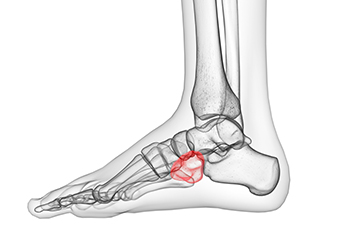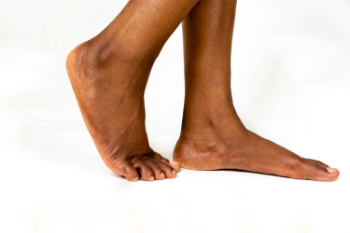Connect With Us
Blog
Items filtered by date: August 2025
Pain on the Side of the Foot Could Be Cuboid Syndrome

Cuboid syndrome is a lesser known cause of foot pain that affects the outer side of the foot. It happens when the cuboid bone becomes slightly out of place, often following an ankle sprain or repeated stress from activities like jumping or running. The pain can feel sharp or aching and is usually worse when walking, pushing off the foot, or standing for long periods of time. Some people describe a feeling of instability or stiffness in the foot. Because symptoms can mimic other foot conditions, it is often overlooked or misdiagnosed. Treatment may involve manual realignment, taping, rest, and wearing supportive footwear. Ignoring the discomfort may lead to ongoing pain or altered movement. If you have unexplained pain along the outer edge of your foot, it is suggested that you schedule an appointment with a podiatrist for a full evaluation and targeted care.
Cuboid syndrome, also known as cuboid subluxation, occurs when the joints and ligaments near the cuboid bone in the foot become torn. If you have cuboid syndrome, consult with Deann Hofer Ogilvie, DPM from Ascend Foot & Ankle Center. Our practitioner will assess your condition and provide you with quality foot and ankle treatment.
Cuboid syndrome is a common cause of lateral foot pain, which is pain on the outside of the foot. The condition may happen suddenly due to an ankle sprain, or it may develop slowly overtime from repetitive tension through the bone and surrounding structures.
Causes
The most common causes of cuboid syndrome include:
- Injury – The most common cause of this ailment is an ankle sprain.
- Repetitive Strain – Tension placed through the peroneus longus muscle from repetitive activities such as jumping and running may cause excessive traction on the bone causing it to sublux.
- Altered Foot Biomechanics – Most people suffering from cuboid subluxation have flat feet.
Symptoms
A common symptom of cuboid syndrome is pain along the outside of the foot which can be felt in the ankle and toes. This pain may create walking difficulties and may cause those with the condition to walk with a limp.
Diagnosis
Diagnosis of cuboid syndrome is often difficult, and it is often misdiagnosed. X-rays, MRIs and CT scans often fail to properly show the cuboid subluxation. Although there isn’t a specific test used to diagnose cuboid syndrome, your podiatrist will usually check if pain is felt while pressing firmly on the cuboid bone of your foot.
Treatment
Just as the range of causes varies widely, so do treatments. Some more common treatments are ice therapy, rest, exercise, taping, and orthotics.
If you have any questions, please feel free to contact our office located in Lafayette, CO . We offer the newest diagnostic and treatment technologies for all your foot care needs.
Get Proper Treatment for Ankle Injuries
Facts About Flat Feet

Flat feet, also known as fallen arches, occur when the arches of the feet collapse or never fully develop. This condition can be congenital or happen over time due to injury, arthritis, obesity, or wear and tear. People with flat feet may notice their feet appear completely flat when standing, with little to no arch visible. Symptoms include foot pain, especially in the heel or arch, swelling along the inside of the ankle, and difficulty standing on tiptoes. Flat feet can also lead to problems in the ankles, knees, or hips as a result of altered alignment. A podiatrist can diagnose flat feet through a physical examination and gait analysis. Treatment may include custom orthotics, supportive footwear, stretching exercises, or, in severe cases, surgery. Proper care helps reduce discomfort and improve foot function. If you have flat feet, it is suggested that you schedule an appointment with a podiatrist who can offer relief tips, and help you to monitor this condition.
Flatfoot is a condition many people suffer from. If you have flat feet, contact Deann Hofer Ogilvie, DPM from Ascend Foot & Ankle Center. Our practitioner will treat your foot and ankle needs.
What Are Flat Feet?
Flatfoot is a condition in which the arch of the foot is depressed and the sole of the foot is almost completely in contact with the ground. About 20-30% of the population generally has flat feet because their arches never formed during growth.
Conditions & Problems:
Having flat feet makes it difficult to run or walk because of the stress placed on the ankles.
Alignment – The general alignment of your legs can be disrupted, because the ankles move inward which can cause major discomfort.
Knees – If you have complications with your knees, flat feet can be a contributor to arthritis in that area.
Symptoms
- Pain around the heel or arch area
- Trouble standing on the tip toe
- Swelling around the inside of the ankle
- Flat look to one or both feet
- Having your shoes feel uneven when worn
Treatment
If you are experiencing pain and stress on the foot you may weaken the posterior tibial tendon, which runs around the inside of the ankle.
If you have any questions please feel free to contact our office located in Lafayette, CO . We offer the newest diagnostic and treatment technologies for all your foot and ankle needs.

